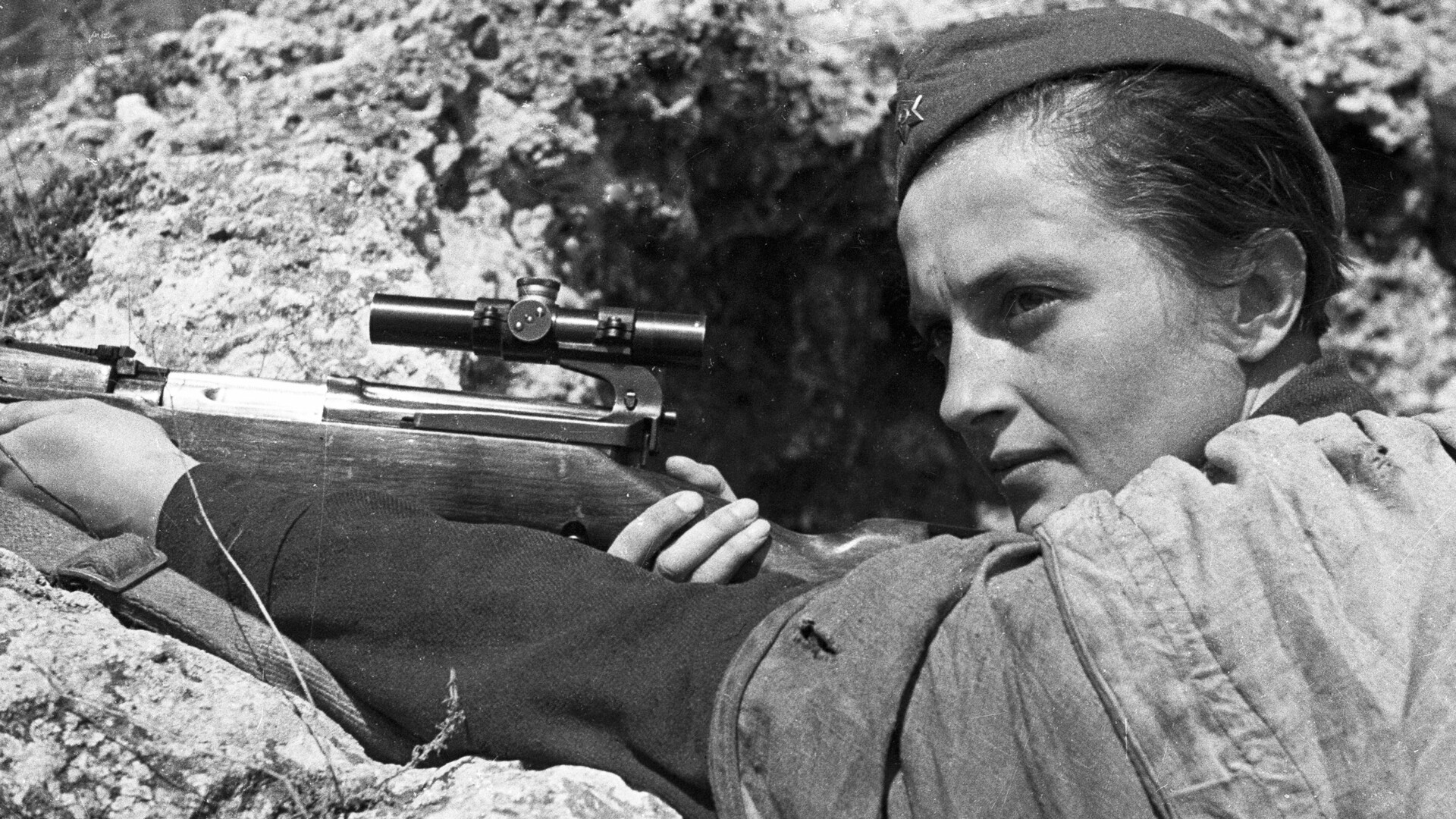
Lyudmila Pavlichenko, 1942.
Israel Ozersky/SputnikOn August 27, 1942, Lyudmila Pavlichenko became the first citizen of the USSR to visit the White House in Washington. The young woman had a short meeting with the president of the U.S., Franklin Roosevelt, and then talked to his wife Eleanor. The first lady befriended her Soviet guest and, later, arranged a trip across the country for her. Just two months prior to that, the 25-year-old Lyudmila got injured for the fourth time and was evacuated from the front of the Great Patriotic War. During the first year of the bloody war with Hitler’s forces, the female sniper eliminated 309 Nazis.
“The first type of sniper work is the sniper hunt. In summer, two of us would depart at half past three in the morning. One sniper pair occupies one place, another pair – another place 300-400 meters away. No talking between us, no whistling, no moving, no smoking – nothing is allowed at all. This lasts until 9-10 PM. Over this time, a sniper can eliminate five Nazis. Maybe three. Maybe none at all. It all depends on how the figures of the enemy are moving. We’re not opening fire at the first one we spot, only at specific ones,” reads an exerpt from Lyudmila Pavlichenko’s recollections.
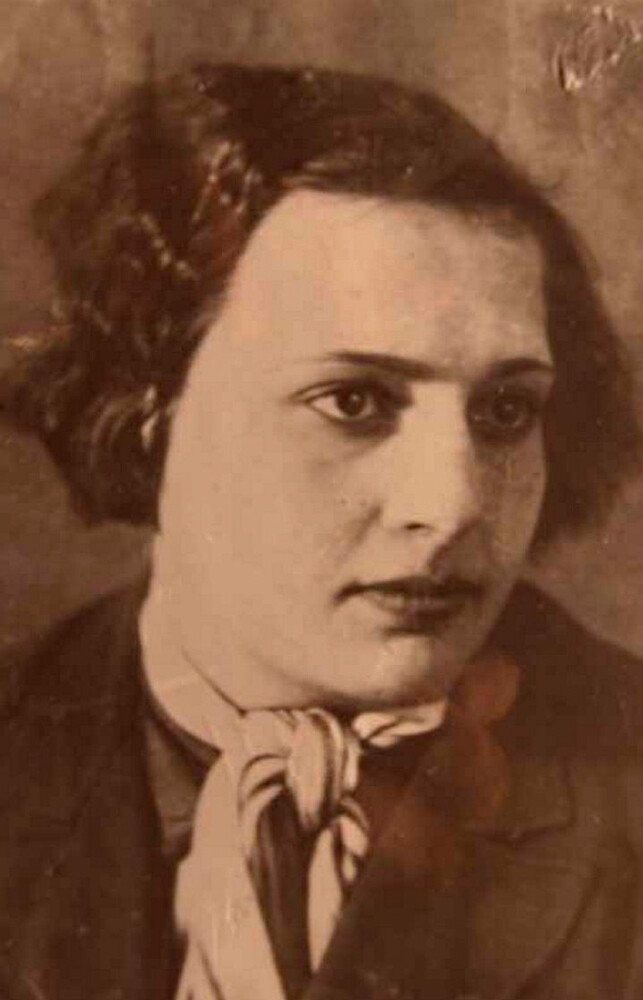
Lyudmila Pavlichenko in her youth.
Archive photoLyudmila was born in 1916 in the city of Belaya Tserkov, not far from Kiev. Since her very childhood, she stood out with her athletic build and, with her fighting spirit, she tried to match boys in everything. When Lyudmila was in tenth grade, she started working at the Arsenal arms factory. There, she grew to love shooting and even completed short-term sniper courses.
“When I heard how a neighbor guy boasted about his shooting range feats, I decided to prove that girls can shoot well, too, and began training hard and a lot,” Pavlichenko told American journalists.
In 1937, Lyudmila joined the History faculty at Kiev University, where she wanted to become a teacher or an academic. However, she was not able to finish her studies – the war caught up with her when she had her pre-graduation practice in Odessa. When Hitler’s troops invaded the USSR, Pavlichenko made a resolute decision to go to the front as a volunteer. However, it was not that easy to do. She wasn’t accepted as a soldier for a while, with refusals supplied with advice to go as a nurse instead. “Girls were not accepted in the army, so I had to use all kinds of tricks to also become a soldier,” she remembered.
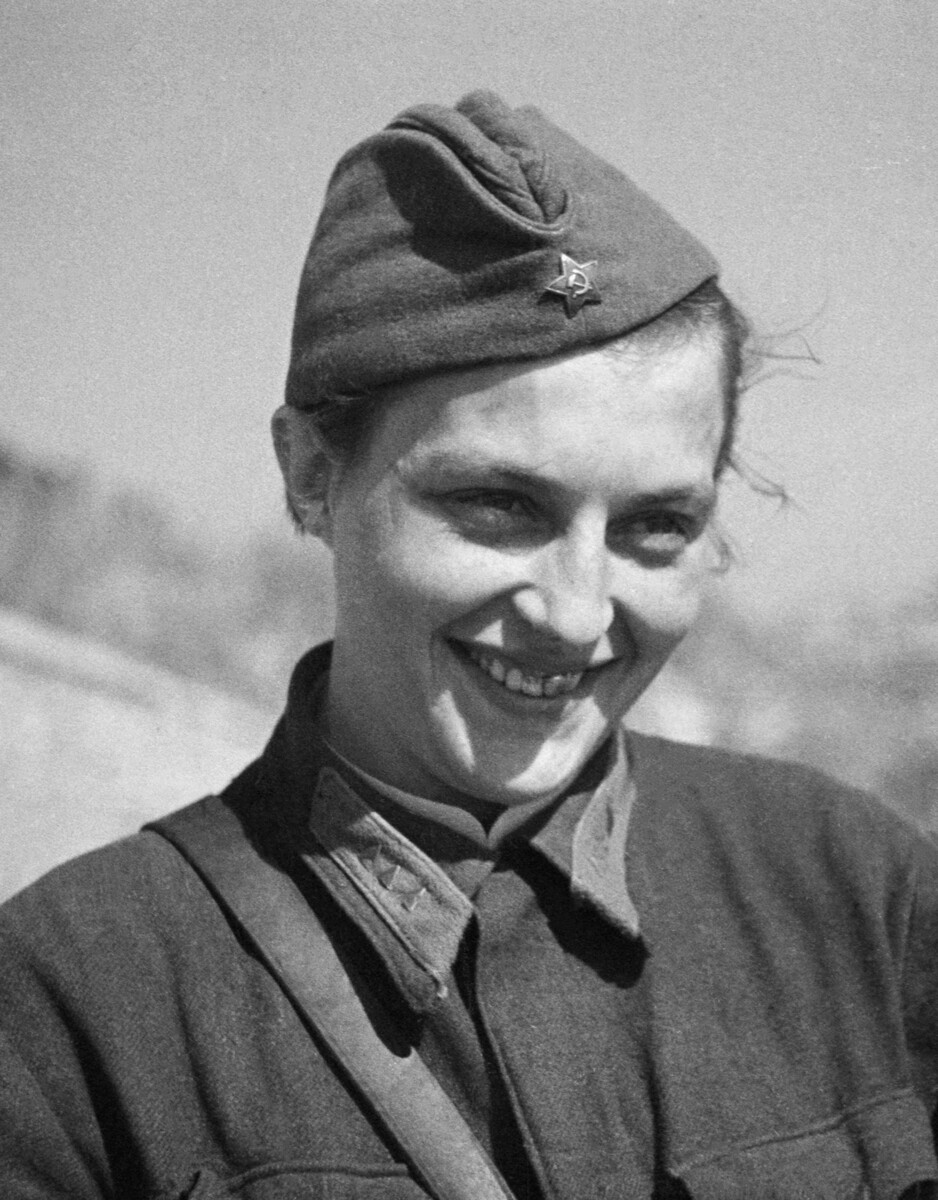
Lyudmila Pavlichenko, 1942.
TASS“The second type of sniper work is sniper duel. To find an enemy sniper, you have to spend about 48 hours. There are check moments – snipers set traps for each other. If the enemy sniper gets caught in your trap, you’re the winner. If you get caught in theirs – it’ll be worse. With very precise targeting through your scope, you can see the hair color, eye color of your opponent, you can even determine how old they are. They can get a good look at you, too. But, the time for a shot has not come yet. A sniper doesn’t get a second shot. It can be 8-10 more hours until the enemy sniper rises. You’ll be harassed by enemy gunners and you’ll have to withstand that. It’s very hard. Only when the enemy sniper believes you’re gone, can he rise up. And then, you take your shot,” reads another exerpt from Lyudmila Pavlichenko’s recollections.
To join the ranks of the Red Army, Lyudmila had to prove her skill in handling weapons and pass an improvised test. They handed her a rifle and pointed out two Romanian officers who were working with the Nazis. Only having killed them, did she prove her readiness to fight alongside men. However, Lyudmila didn’t include these hits into her 309-kill list, she viewed these eliminations as tests. Private Pavlichenko was enlisted in the 25th rifle division of the Red Army named after Vasily Chapaev, a famous commander of the Russian Civil War.
During the first months of the Great Patriotic War, Lyudmila fought in Moldova and the city of Odessa. Already more than a hundred of Nazi soldiers and officers died from her rifle there. Then, her regiment was transferred to Crimea and she took part in the heroic defense of Sevastopol.
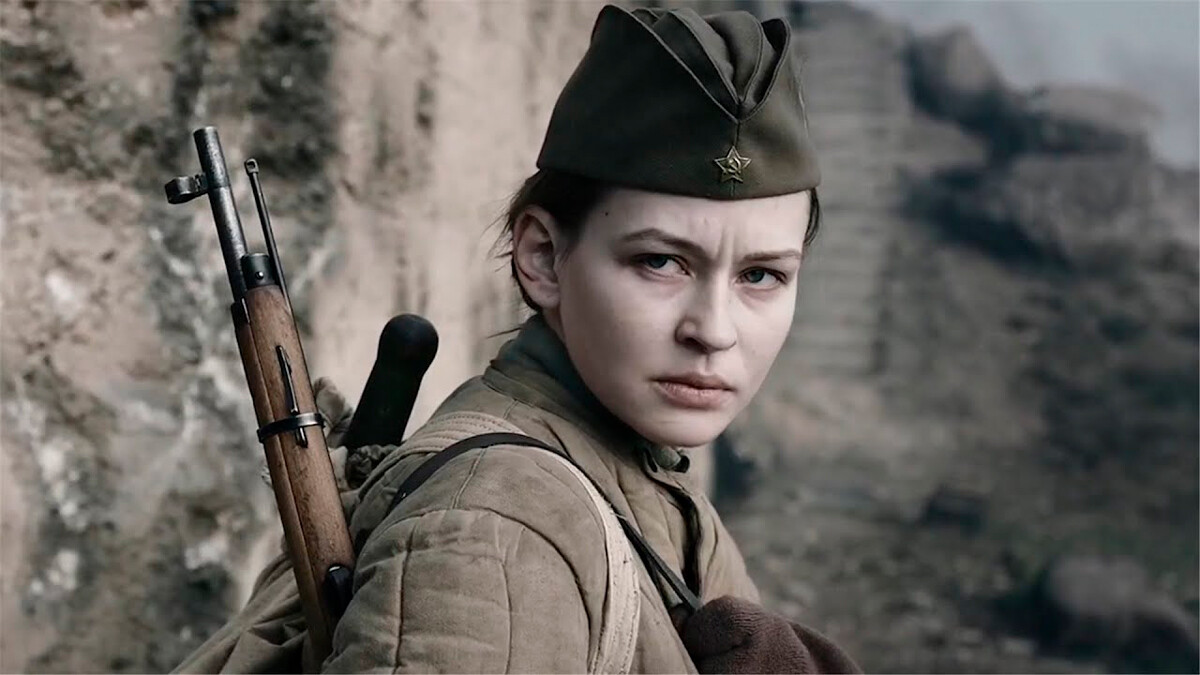
Yulia Peresild as Lyudmila Pavlichenko in the movie "Battle for Sevastopol".
directed by Sergei Mokritsky, 2015/KinoDeloIn the Battle of Sevastopol, the Germans significantly outnumbered Soviet soldiers, so Lyudmila had plenty of targets. In May 1942, at a count of 257 kills, she earned praise from the military council of the Red Army on the Southern Front. In response, the best female sharp shooter of the Soviet army promised to kill even more. The command especially noted her mastery of sniper duels – Lyudmila had eliminated 36 enemy snipers that the Wehrmacht had sent specifically to liquidate her.
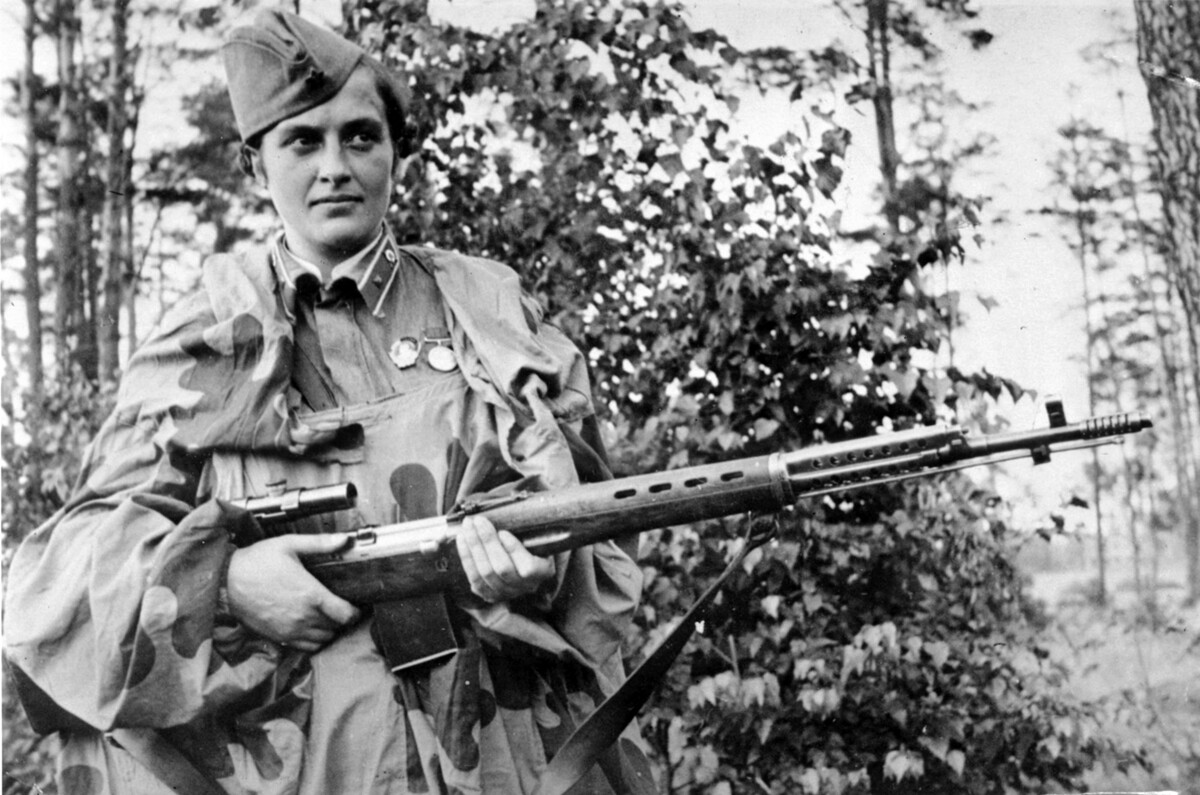
Pavlichenko was given the rank of senior lieutenant and she headed a rifle squad, which she formed herself from fresh-on-the-front soldiers. To Lyudmila’s direct superior, senior lieutenant Dronin, such an appointment seemed abnormal. It was absurd for him to see a girl in an officer’s rank; however, he didn’t oppose the high command’s orders.
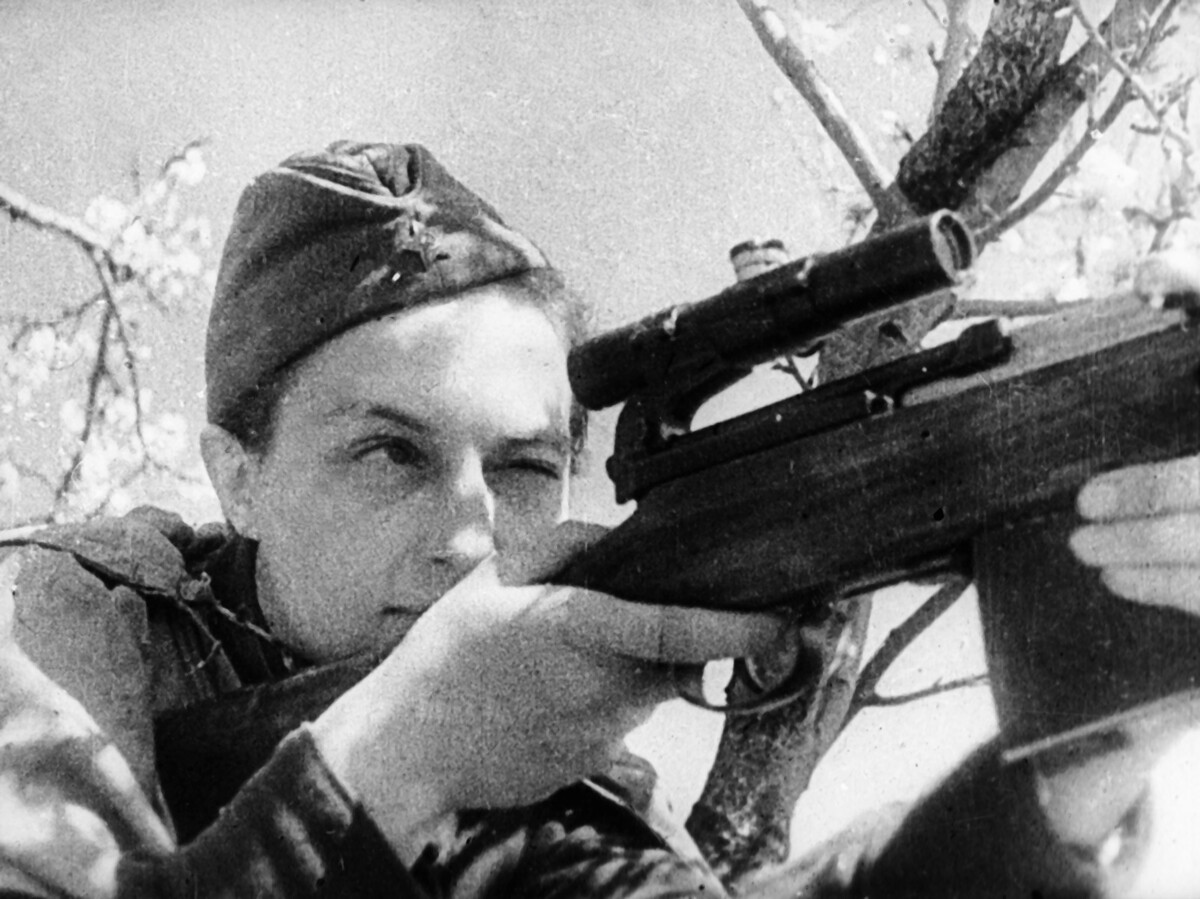
Lyudmila Pavlichenko, the defense of Sevastopol.
Vladislav Mikosha/Sputnik“When snipers escape the enemy, if someone from us falls down – a wounded sniper doesn’t fall, only a dead one – our entire squad stops and enters the fight. And, if someone else gets killed, our fallen comrade will be retrieved anyway. You can’t leave the body of your comrade on the soil captured by the enemy. That wasn’t written in any chapter, but it was a strict law among snipers,” reads another exerpt from Lyudmila Pavlichenko’s recollections.
Before the war, Lyudmila Pavlichenko’s personal life hadn’t gone too well. Her childhood ended early – she gave birth to her son Rostislav when she was just 15. Alexei Pavlichenko, the father of the child, was much older than Lyudmila. The girl was unhappy in marriage and soon divorced her husband, returning to live with her parents. She told no one about her early marriage and didn’t even mention it in her short ‘Autobiography’, which is now stored in the Central Archives of the Russian Ministry of Defense.
Lyudmila met the love of her life on the front. During the battles near Sevastopol, she met junior lieutenant Leonid Kitsenko, who was also a sniper. Evenings spent by the fire with sniper routine stories quickly grew into a front romance. The lovers began to go to combat missions together, which only strengthened their relationship. Soon, Lyudmila and Leonid made an official report to the command, asking to allow them to marry, but, in the end, the war didn’t allow them to become husband and wife officially.
In March 1942, Nazis hit the Red Army sniper positions with mortar fire and Leonid suffered a mortal injury. Lyudmila survived by a miracle – her beloved covered her from shrapnel with his own body. She carried Leonid away from the battlefield, but he couldn’t be saved.

Lyudmila Pavlichenko and Leonid Kitsenko. Sevastopol, February 1942.
Archive photoThe death of lieutenant Kitsenko only bolstered Lyudmila’s fighting spirit and she fought the invaders even more furiously. Pavlichenko admitted that she killed Nazis without remorse and the only thing she felt was a “hunter’s satisfaction” from killing a predator: “Every living and healthy German would easily kill a woman, a child, anyone. That means, by killing Germans, I save lives.”
But, in June 1942, Lyudmila was seriously wounded by mortar fire. She was evacuated from besieged Sevastopol and sent to the Caucasus; after that, she was recalled from the front overall. Her next mission was a trip to the United States.
“The Nazis were so humiliated by Sevastopol and Odessa snipers that, in April 1942, they changed all their shooters and sent their aces to Sevastopol. Over the radio, the Nazis claimed that Sevastopol snipers would be eliminated. For us, this was a serious insult. We decided to go out in the field and we spent more than a day to spot this ace. The guys wanted to take him alive, he didn’t resist. His sniper book read ‘502’. We asked him where such a number came from and on which sites they operated. It turned out that the Nazi sniper graduated from the officers’ sniping school and then, to get accustomed with killing, he was sent to death camp security. I still can’t comprehend how a sniper could kill a woman on the parade ground or a child or a man who’s captured and without a weapon. In my opinion, this is beast-like, not sniper-like,” reads another exerpt from Lyudmila Pavlichenko’s recollections.
In the U.S., Lyudmila had an important diplomatic mission – to persuade the Americans of the necessity to open a second front. That would allow for a separation of the Nazi forces and would give the Soviet army an opportunity for a counterattack.
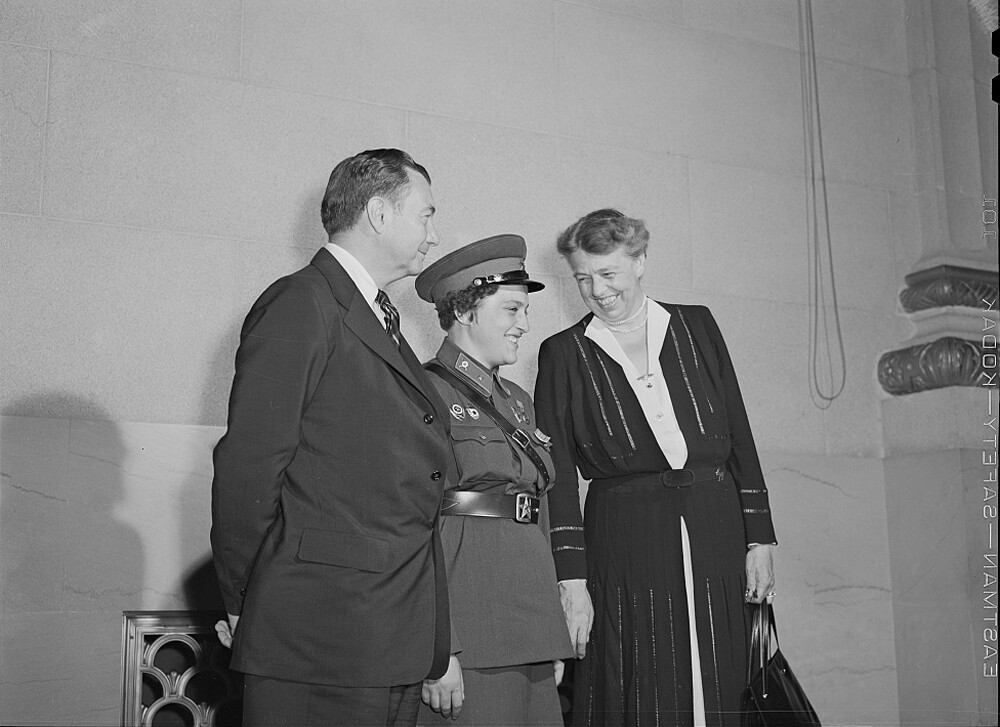
Washington, D.C. International youth assembly. Liudmila Pavlichenko, famous Russian sniper, with Mrs. Roosevelt and Justice Robert Jackson.
Jack Delano/Library of Congress Prints and Photographs Division WashingtonPavlichenko arrived in the United States at the end of August 1942, along with Moscow Komsomol Committee’s secretary Nikolai Krasavchenko and sniper Vladimir Pchelintsev. The Soviet delegation was met with a warm reception: “To our surprise, the railway station was full of students. They came from across the globe to greet the Red Army, represented by us. The army that was fighting the Nazis to the death.”
Lyumdila immediately became a star of American newspapers; however, journalists often talked about her not in the context she preferred. She was under an avalanche of inconvenient and even absurd questions: ‘Why doesn’t a Soviet sniper pay proper attention to their appearance? Are Russian women allowed to apply makeup on the front? What lingerie color do you prefer?’

Washington, D.C. International youth assembly. Liudmila Pavlichenko, a delegate from Russia.
Jack Delano/Library of Congress Prints and Photographs Division WashingtonLyudmila tried to fight off the American press the best she could: ‘“ wear my uniform with pride! The Order of Lenin on my chest was washed with blood. It’s obvious that silk lingerie under uniform is much more important for American women – more than the uniform itself, the true purpose of which, by the way, they have yet to learn.”
Pavlichenko spent three months in the U.S.; during her trip across the country, Lyudmila talked to Eleanor Roosevelt a lot. It seems that the first lady gave the Soviet girl some useful advice about talking to the press, since, with time, her speeches became more and more convincing. She delivered speeches in front of audiences counting thousands of people; she spoke about her youth and front routine, as well as about the atrocities committed by the Nazis on her home soil. The press gave Lyudmila the nickname ‘Lady Death’; a famous American country singer, Woody Guthrie, also composed the song ‘Miss Pavlichenko’ as a tribute to her: “This world will love your sweet face the same way I've done; 'Cause more than three hundred nazzy hound fell by your gun.”
Lyudmila never forgot the main goal of her visit to the U.S. and continued to insist that Americans were obligated to help Europe and the Soviet Union in the fight against Hitler. At one of the press conferences, having grown tired from questions about the routine of a female sniper, she said her famous phrase: “I am 25 years old and I have killed 309 fascist invaders by now. Don't you think, gentlemen, that you have been hiding behind my back for too long?” The audience met these words with applause; American society realized the necessity of helping the Eastern front. U.S. authorities increased the supplies of arms and vehicles to the USSR; however, the long-awaited opening of a second front happened only two years later – in the Summer of 1944, when the Soviet army had already seized the initiative and was leading an active counteroffensive against the Nazis.
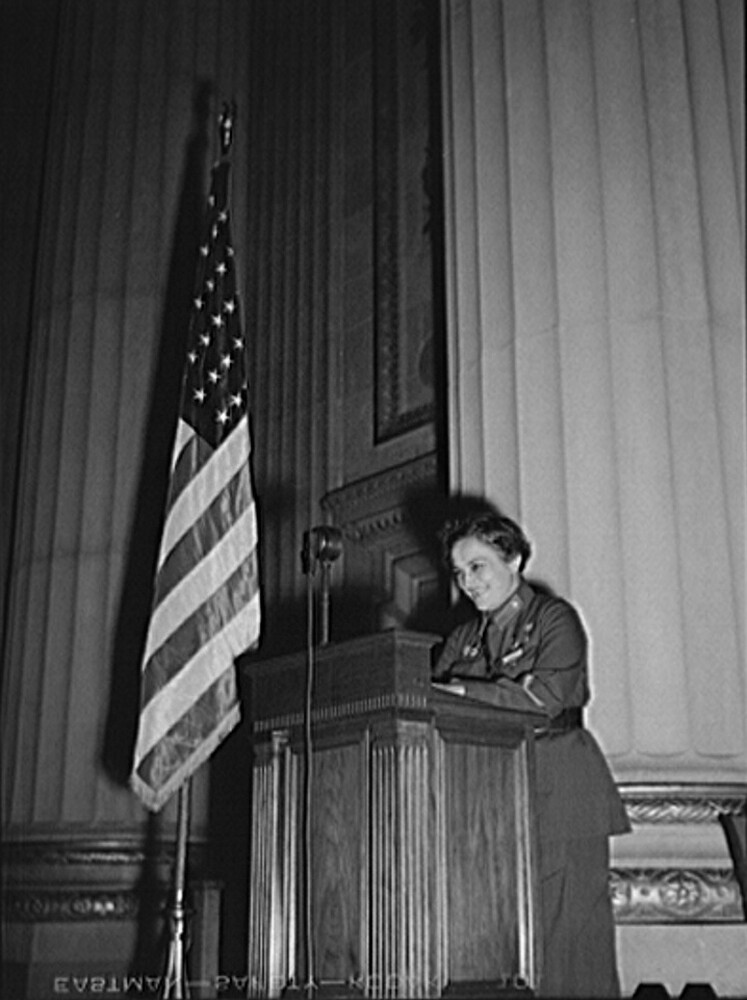
Washington, D.C. International youth assembly. The delegate from Russia, Liudmila Pavlichenko, is addressing the convention.
Jack Delano/Library of Congress Prints and Photographs Division WashingtonHaving returned to the USSR, Lyudmila Pavlichenko began training shooters at sniper courses. More than 1000 students went through her school, many of which became prominent snipers and helped the country triumph in the Great Patriotic War. In 1943, the authorities presented Lyudmila with the highest award – the title of the Hero of the Soviet Union. After the war, she finally graduated from Kiev University and became a senior fellow of the Soviet Navy Headquarters.
Lyudmila maintained her correspondence with Eleanor Roosevelt; the friends continued to exchange letters right until the death of the first lady. In 1957, they met again when the American arrived in Moscow on a business visit. Lyudmila received Eleanor in her apartment, where they warmly chatted and remembered Lyudmila’s trip to the U.S that had made them friends.
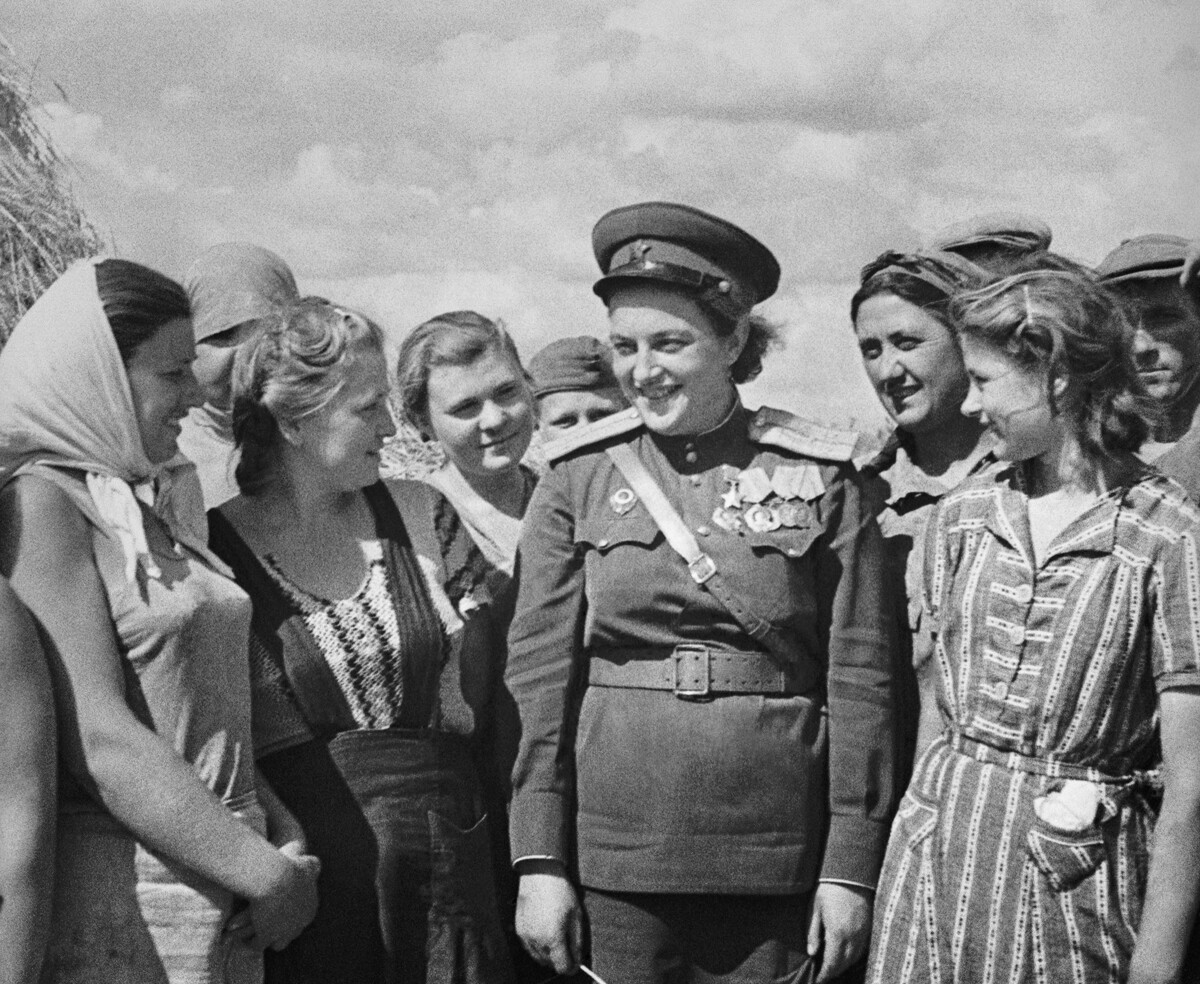
Ukrainian SSR. Odessa Region. July 31, 1944. Lyudmila Pavlichenko and workers of the collective farm "Vilny Burlak" during a meeting.
TASSLyudmila Pavlichenko died in 1974 at the age of 58. Her front line injuries had a serious impact on her health. The best female sharp shooter was buried in Novodevichy cemetery in Moscow.

Ukrainian SSR. Odessa Region. June 11, 1971. Hero of the Soviet Union, Lyudmila Pavlichenko at the Belt of Glory monument in the village of Dachnoye.
Ilya Pavlenko/TASSDear readers,
Our website and social media accounts are under threat of being restricted or banned, due to the current circumstances. So, to keep up with our latest content, simply do the following:
If using any of Russia Beyond's content, partly or in full, always provide an active hyperlink to the original material.
Subscribe
to our newsletter!
Get the week's best stories straight to your inbox